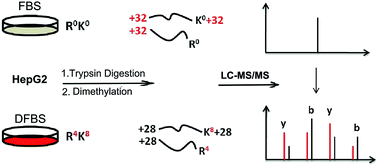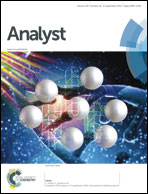Global in vivo terminal amino acid labeling for exploring differential expressed proteins induced by dialyzed serum cultivation†
Abstract
Taking advantage of reliable metabolic labeling and accurate isobaric MS2 quantification, we developed a global in vivo terminal amino acid labeling (G-IVTAL) strategy by combining metabolic labeling and isotopic dimethyl labeling for quantifying tryptic peptides. With G-IVTAL, the scale of qualitative and quantitative data can be increased twofold compared with in vivo termini amino acid labeling (IVTAL) in which Lys-N and Arg-C are used for digestion. As a result, up to 81.78% of the identified proteins have been confidently quantified in G-IVTAL-labeled HepG2 cells. Dialyzed serum has been used in most SILAC studies to ensure complete labeling. However, dialysis requires the removal of low molecular weight hormones, cytokines, and cellular growth factors, which are essential for the cell growth of certain cell lines. To address the influence of dialyzed serum in HepG2 growth, the G-IVTAL strategy was applied to quantify the expression differences between dialyzed serum- and normal serum-cultured HepG2 cells. Finally, we discovered 111 differentially expressed proteins, which could be used as references to improve the reliability of the SILAC quantification. Among these, by using western blotting, the differential expressions of MTDH, BCAP31, and GPC3 were confirmed as being influenced by dialyzed serum. The experimental results demonstrate that the G-IVTAL strategy is a powerful tool to achieve accurate and reliable protein quantification.


 Please wait while we load your content...
Please wait while we load your content...